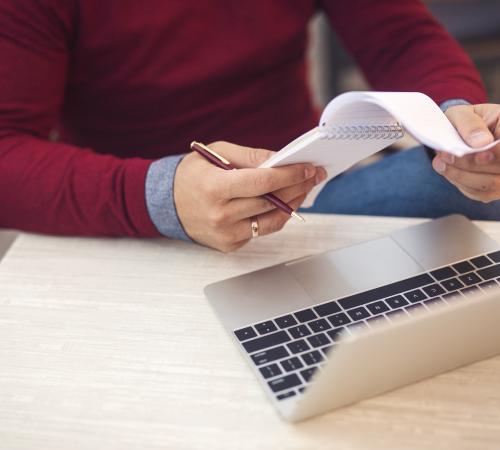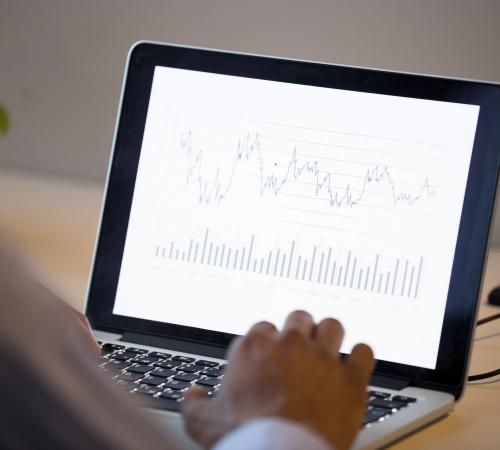

Our guide can help with understanding your employment status, Self Assessment tax return record management, and how much you might be asked to pay on your income.
What does it mean to be self-employed?
A self-employed person is defined as someone who accepts accountability for their business and runs operations themselves.
Being self-employed can mean working in a more flexible way to suit your way of life. It also involves managing the work you do and being your own boss – which means knowing how to pay your taxes and National Insurance.
There can be many benefits to being self-employed, from being able to set your own rates to welcoming diverse projects and working from wherever you choose. You might also be able to deduct utilities and travel expenses from your income.
However, it’s worth bearing in mind all aspects of this way of working. There may be times when your income isn’t certain, holidays might be tricky to take and getting approval for property rental or purchase could be more difficult. You’ll also need to shoulder certain administrative tasks – including taking care of your own tax and National Insurance – and responsibility for things that might go wrong.
Some of the responsibilities of self-employment may include:
- Knowing how to keep detailed financial records and how to pay tax
- Securing financial backing to get started and be sustainable
- Having business insurance in place to back you up for accidents, mistakes and misunderstandings
- Sourcing your own business opportunities
- Compliance with the rules and regulations of your industry
Working out your employment status – types of employment
While it may seem simple to identify employment status at first glance, when you dig a little deeper, it may be complex. For instance, if you have more than one job, your status could be different for each. Understanding whether your employment status is self-employed or employed is important for knowing how to pay your taxes.
The government’s Check Employment Status for Tax (external link) tool is simple to use and can quickly help you identify your appropriate status.
Self-employment is just one type of employment status. There are several others to be aware of, too, including:
Worker
The government defines a worker (external link) as someone who has ‘a contract or other arrangement to do work services personally for a reward.’ A worker’s contract doesn’t necessarily need to be written.
Employee
An employee (external link) is someone who carries out their work under an employment contract which requires them to work a minimum number of regular, paid hours.
Director
Someone who heads up, or runs a limited company for shareholders is commonly called a company director (external link). It may be important to understand the difference between a director and an employee since, for tax and National Insurance purposes, the former are classed as office holders (external link).
Contractor
Being a contractor (external link) is a little different to other employment statuses. A contractor can be self-employed but could also be employed or classed as a worker if they are employed through an agency for a client.
How to register as self-employed
Often, the first thing a self-employed professional needs to do is register their new employment status with HMRC (external link).
There are three key steps to registering as self-employed if you haven’t submitted a return online before:
- Online registration (external link) – to do this, you’ll need a Government Gateway ID and a password (if you don’t yet have these details, you can create them) to sign into your business tax account. You’ll then need to add ‘Self Assessment’.
- UTR letter – within 10 days of registering, UK residents will receive a letter containing their Unique Taxpayer Reference number. You need these details to file your return.
- Activation code – once you’ve received your UTR letter, you’ll get another one with the details of your account activation code. After using this to activate your account, it’s possible to file your return any time before the deadline.
As a guide, the tax year runs from 6 April to 5 April the next year – the latest you can register for a Self Assessment return is 5 October in your business’s second tax year.
How to pay tax and national insurance when self-employed
As a self-employed professional, it’s your responsibility to understand your status, follow the registration process and know how to pay the required National Insurance and tax.
Once you submit your Self Assessment, HMRC will use your information to calculate how much self-employment tax you need to pay.
Paper submissions need to be made by the October deadline, while online returns are due by the January deadline. The payment itself is also due in January.
What is National Insurance?
National Insurance is a type of tax that’s applied to the money you earn, whether you’re self-employed or employed.
This tax is then collected by the government to fund certain state benefits. These include:
- Unemployment benefits
- Maternity pay
- Sick pay
- State Pension
What is income tax?
Income tax (external link) is a type of tax you pay on your income – however, it’s not applicable to all forms of income.
It applies to:
- Employment earnings
- Self-employed profits
- Certain state benefits
- Pensions
- Savings interest
- Rental income
- Trust income
How to file your self-employed Self Assessment tax return
Familiarising yourself with the main SA100 tax return form and the different SA103 forms can help make the process smoother.
These are supplementary pages to add to your main SA100 tax return form. There are two types of SA103:
- The shorter SA103S (external link) can be filed by most self-employed individuals when their annual business turnover falls below the VAT threshold
- The full SA103F (external link), which is used by sole traders and those with more complicated business circumstances when their annual business turnover climbs above the VAT threshold
Here’s a guide for filing the SA103 section of the Self Assessment tax return:
- Choose the form from the correct year and download the PDF form
- Print the form and fill out your details – this will include your name, UTR, business details, income and expenses details
- Send the form to HMRC along with the SA100 form – the SA103 cannot be sent without the main form
When do I need to send my tax return to HMRC?
The tax return deadline schedule in the UK features key annual dates you need to be aware of for submitting to HMRC.
Once you’ve registered, the form should be filled in and returned in full:
- The deadline for paper tax returns is midnight on 31 October
- The deadline for online tax return submissions is midnight on 31 January
Once you’ve submitted, you need to pay the self-employment tax you owe as a balancing payment and the first ‘payment on account (external link)’ by midnight on 31 January. The second payment on account is due by 31 July.
These deadline dates are usually the same each year to keep it simple for knowing when to pay and avoid receiving penalties.
Making Tax Digital (MTD)
Making Tax Digital is a government initiative to digitise the tax system and make it easier for individuals and businesses to stay on top of their taxes.
VAT: All VAT-registered businesses are legally required to keep digital records and file their VAT returns using MTD-compatible software. This requirement has been in place since 1 April 2022.
Income tax: From April 2026, self-employed individuals and landlords with an annual income over £50,000 must follow MTD for income tax. This threshold will fall to £30,000 from April 2027.1 (external link)
Do self-employed workers pay National Insurance?
As a self-employed person, you will need to pay National Insurance (external link) if your profits are high enough.
Figures may be subject to change depending on the year, so it’s always a good idea to check directly with HM Revenue & Customs.
There are four classes (external link) of National Insurance:
- Class 1 – Employees earning over £242
- Class 1A and 1B – Employers pay directly on benefits or expenses of the employee
- Class 2 - Self-employed making £6,725 or more annually
- Class 3 – Contributions that are voluntary
- Class 4 – Self-employed making £12,570 or more annually
How much can you earn tax free if you're self-employed
Understanding how much you can earn before you need to pay tax can help with budgeting when you’re self-employed.
How much income you can have before you pay is called Personal Allowance (external link). The tax-free Personal Allowance in the UK is £12,570 as standard.
However, this may be higher if you claim other allowances, such as Marriage Allowance. Personal Allowance is also smaller if you earn more than £100,000 and not applicable for those earning over £125,140.
Checking the details of Personal Allowance (external link) directly with HM Revenue & Customs can help ensure your finances are accurate, as this may also be subject to change. The below table shows the differences from 2021/22 to 2024/25:
| Allowances | 24/25 | 23/24 | 22/23 | 21/22 |
| Personal allowance | £12,570 | £12,570 | £12,570 | £12,570 |
| Income limit | £100,000 | £100,000 | £100,000 | £100,000 |
Tax rates are as follows:
- Personal Allowance – Up to £12,570 at 0%
- Basic – £12,571 to £50,270 at 20%
- Higher – £50,271 to £125,140 at 40%
- Additional – Over £125,140 at 45%*
*Information accurate as of August 2025
How much tax do you pay if you are self-employed?
How much tax self-employed people pay will be dependent on annual income. It will also depend on what HMRC calls ‘allowable expenses’ and the total of these during the same period.
This is because there are certain business expenses you may choose to take from your income when you file your return – this could include costs you’ve incurred for travel and relevant utilities. This will then affect the calculation of your taxable profit.
The first £12,570 of your self-employed income is tax-free – so then you need to calculate how much tax you need to pay after that.
Anything you earn between £12,570 and £50,270 will then move up to the next rate of 20%. If you make between £50,271 and £125,140, you’ll jump up another rate to 40%. There’s also an additional rate of 45% for those who earn over £125,140.
If your business earns £33,000, and that’s the total you enter for your return, you can deduct the tax-free £12,570. This leaves you with a 20% tax to pay on £20,430 – which is a total tax payment of £4,086.
It’s important to note that you’ll pay the applicable tax rate on the portion of your salary within each tax band.
To calculate your self-employed tax for yourself, you can use the HM Revenue and Customs Self Assessment ready reckoner (external link) tool.
What happens if you're also employed?
When you’re both employed and self-employed, a few more calculations are involved in making sure you’re paying the correct tax, plus ensuring the businesses you work for are following the rules.
In these circumstances, you’ll need to pay self-employed tax through your Self Assessment and your employed tax via PAYE. Therefore, for your self-employed work, you’ll need to use the above calculations and only pay tax on earnings above £12,570.
It’s also important for HMRC to be aware of the details of both your self-employment and employment to ensure that any company you work for can follow the legal tax rules.
If you are unsure whether your work counts as employment or self-employment, think about how you work and how you are paid. You’ll know you’re self-employed if you are paid upon submitting an invoice to your client and able to dictate where and when you work.
Can I pay tax as I go, or monthly, if self-employed?
Ensuring you know how to pay your self-employed tax effectively also means planning to make tax payments line up with your own business and circumstances.
It’s possible to pay in instalments (external link) by setting up a payment plan with HMRC, but this method does involve paying interest.
Alternatively, you can keep on top of calculating your tax and put money aside in a tax pot monthly to make the large yearly bill more manageable.
Key takeaways for keeping on top of tax
Knowing how to set up for Self Assessment and pay your own tax return is incredibly important for a self-employed person.
While it may seem daunting to understand at first, there are ways to keep on top of your self-employed tax routine.
Tips include:
- Start gathering details for your return early and get organised
- File online – it’s even possible to save and continue later
- Calculate your tax as you go and keep aside a pot of money monthly
- Seek help from HMRC (external link) – especially if it’s your first Self Assessment
Disclaimer:
At Hiscox, we want to help your small business thrive. Our blog has many articles you may find useful as you navigate your business tax obligations. But taxes are complex and legislation changes regularly. These articles aren’t professional tax advice. To find out more about a subject we cover here, please seek professional tax assistance.






